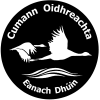We are continuously adding information to our website on various aspects of local history. Posts are divided as follows.
- Townlands contains pages for each townland in the parish, giving geographical information and population statistics together with details on land and house occupancy, and some genealogical information where available;
- People contains posts on interesting or well-known people in Annaghdown;
- Buildings contains posts on noteworthy buildings in the parish, including castles, ruins, and churches;
- Our Genealogy page provides a brief outline on the resources available for tracing your Annaghdown family history;
- Topics contains other posts which do not fit into the categories above.
The history of Annaghdown has many aspects, and perhaps a natural first question is ‘how far back can we go?’ The answer we have at present is that Annaghdown was inhabited in the Bronze Age (2000-500 BC). During this period, a broad-headed, broad shouldered, strongly built man, of about 5 feet 8 inches in height and something of over forty years of age, died and was buried in a cist grave at Park, not far from the present Galway-Headford Road. The grave was discovered in 1934 during quarrying works.
With the arrival of Christianity in the fifth century, monasteries began to appear on the landscape, and so it was that the monastery of Annaghdown was founded by St Brendan and his sister St Briga around 550 AD, in the territory of the little-known Delbhna Cuil Fabhair, on the south-east shore of Lough Corrib. Nothing remains of the original monastic settlement, but with the passage of time Annaghdown grew in power, attracting in the late 12th century two Continental monastic orders, the Arrouaisians and Premonstratensians, and it rose after 1179 to become one of the five bishoprics of Connacht.
This has left us with a well-preserved medieval landscape which includes two abbeys, remains of the monastic enclosure, old oratory, ancient parish church with one of the finest examples of Hiberno-Romanesque sculpture in its east window, and the stump of a round tower. In the surroundings lie the late-12th century bishop’s palace and its successor the 15th century castle, the monk’s fishpond and causeway, the holy wells of St. Brendan and St. Cormac, and the ringfort recorded in the annals as the seat of the Uí Flaithbertaig, which likely gave its name to Annaghdown: the marsh of the fort. Other survivals of this era in the parish include the remains of Teampall Chathail, an 11th or 12th century church at Corrandrum. The seventeenth and eighteenth centuries saw the consolidation of landed estates including the Kirwans and Blakes of Cregg, the Stauntons of Oldbury and Waterdale, the Lynches of Corrandulla, Balrobuck and Galway, and the Skerritts of Drumgriffin and Luimnagh.
The nineteenth century brought famine and a huge decline in population to Annaghdown, with the population almost halved by starvation and emigration during the Great Hunger. Access to commerce was greatly improved in the 1860s with the opening of the Curraghline connecting Annaghdown to Galway, a trip which was quite arduous before then. Brick-making in the western part of the parish provided an opportunity for supplementing income at this time, with bricks transported by lake to Galway for building works there. Connections with the outside world were strengthened in the 1830s with the establishment of the Post Office at Drumgriffin. Most of the domestic and farm buildings during this period were thatched, and several fine examples of nineteenth century thatched cottages can be found dotted around the parish. Education also greatly improved in the ninteenth century, when the National School system replaced hedge schools and informal private schools. The Franciscan Brothers arrived in Corrandulla in 1851 and took charge of boys’ education, and other national schools were later established at Corrandulla (Girls’), Annaghdown, Corrandrum and Castlehacket.
Ecclesiastical development also took place following the relaxation of the Penal Laws, and in 1831 the foundation stone was laid for the new St Brendan’s Church in Corrandulla. A second church, St Brendan’s By the Lake, was dedicated at Woodpark in 1903. Insights into living conditions at the turn of the century are available from the account of Arthur Bragington, who visited from the US in 1900. He was one of thousands of Annaghdown descendants now scattered throughout the world, with emigration to the United States, New Zealand, and Australia becoming particularly popular in the nineteenth century.
Many improvements in quality of life came in the twentieth century, with the establishment of group water schemes bringing piped water to rural areas, removing the need to carry water from wells. The increased mechanisation of agriculture led to the demise of mills, which facilitated the local grinding of corn, as well as forges, which provided a important social outlet as well as an important community service. Much information on life in the parish in the 1930s, and local folklore in general, is contained in the Schools’ Folklore Collection.
We welcome submissions of any relevant material for publication on this site – please contact us if you have material to submit. We regularly interact with heritage organisations in neighbouring parishes, including Donaghpatrick-Kilcoona Heritage Society, Lackagh Museum, and Claregalway Historical Society.
